2
The Disconnect Between the Ideal and Reality
Research training immediately after the doctoral degree can be a productive period for many researchers, and an essential step on the path to an independent research career. The experiences gained during these postdoctoral years facilitate the development of research careers in science, engineering, and medicine. Unfortunately, the term “postdoc”—as the period of postdoctoral training and the people who purse postdoctoral training have both come to be colloquially known—is associated with many interpretations (see Box 2-1), and too often does not align with the ideal of a temporary and definite period of mentored advanced training in research.
The standard model of academic scientific research that has developed in the United States over the past century is based on a core research group led by at least one principal investigator, and may include staff scientists, postdoctoral researchers, graduate students, technicians, and even undergraduates. In this structured research unit, postdoctoral researchers play a critical role in supporting the day-to-day operations of a research laboratory. In return, they gain experience to further their own independent research careers (Stephan 2012).
The ideal scenario for a postdoctoral researcher’s experience might be as follows.3 A self-selected, motivated, recent doctoral degree recipient receives additional scientific training (to augment previous training during graduate school) for a limited time before transitioning to a full-time research position, often as a tenure-track faculty member. Under the mentorship of a principal investigator, the postdoctoral researcher learns new tools and techniques of research and gains access to professional networks and relationships that are crucial to securing a faculty or other position. Along the way, the postdoctoral researcher accrues publications—the valued currency of the academic and research worlds—and learns the arcana of grantsmanship and other vital skills of the trade.
In exchange for the skills and knowledge gained during this training, the postdoctoral researcher provides highly skilled, low-cost research labor to the laboratory, often bringing new techniques that complement the principal
_____________________________
3 This is primarily for university-based postdoctoral researchers, which is the largest category.
Box 2-1
What is in the Name “Postdoc”?
The nomenclature that is used to refer to this increasing segment of our science and engineering workforce is reflective of many of the issues that arise in this report. The word “postdoc” is a truncation of the adjective “postdoctoral,” which describes a period of time, and is conveniently used to modify many types of positions, including traineeships, fellowships, research scientists, and other related titles. In referring to people who are in postdoctoral positions, the word “postdoc” has also become a noun.
A “postdoc” is the only stage in the education, training, and career development of a scientist or engineer that is referred to only by the period of time, and not the position itself. Because there is no agreed-upon specific title, there is no agreed-upon set of goals or outcomes for the position. Is it intended to be a continuation and enhancement of the in-depth education of the Ph.D. and graduate school (traineeship)? Or is it an entry-level career position with the corresponding benefits and job training expected from any entry-level position (researcher)?
In addition, by referring to the time period and not the position, there is little consistency in how institutions identify individuals during this stage or how individuals identify themselves. This conundrum hampers data collection efforts. Some—perhaps, many—of those individuals currently labeled “postdocs” by their principal investigators, institutions, or funding agencies should hold very different titles (e.g., research scientist).
Even the time period that the adjective “postdoctoral” describes is ambiguous and ill-defined. The only qualification that is required for any position to be postdoctoral is that it occurs after the receipt of a doctoral degree (in the European Union, it can be argued to be after the receipt of any terminal degree). This period is open ended and therefore, taken glibly, once doctoral candidates have completed their degree, they are technically, and indefinitely, postdoctoral. Practically, this term stops being used once they transition to a different role, like professor or research scientist.
In this report, the committee determined that the most appropriate title for this segment of the workforce is “Postdoctoral Researcher.”
investigator’s research group. The postdoctoral researcher contributes directly to publications and grants—and hence to the productivity of the research group. The postdoctoral researcher may also work with graduate students and other laboratory members, allowing the principal investigator to attend to duties such as teaching, fundraising, and administration. Ideally, this symbiotic relationship benefits all parties involved.
During the first half of the 20th century, when the scale of scientific research was relatively small, the reality of the postdoctoral experience was strongly aligned with the ideal (see Box 2-2). However, the dramatic shift toward “big science” during and following World War II, which has only increased in the subsequent decades, has resulted in a system that often requires ever larger teams of graduate students, postdoctoral researchers, and other
Box 2-2
Historical Context of the Postdoctoral Enterprise in the United States
The Start: The current system of postdoctoral research in the United States arose after World War I in an effort led by the National Research Council and the Rockefeller Foundation to strengthen basic research in physics and chemistry to be competitive with other leading nations, especially Germany. In the 1920s and 1930s, postdoctoral researchers quickly developed a role in managing the day-to-day research operations of laboratories, allowing faculty time to supervise other research, teach, obtain funding, and attend to other administrative tasks.a
The Surge: Following World War II, funding for basic research at universities shifted from foundations and private industry to the federal government. The growth in the numbers of postdoctoral researchers mirrored the general increase in funding. In the 1960s, approximately 10 percent of doctoral graduates went on to a postdoctoral position, although the growth in the biomedical fields was quickly outpacing other areas of science and engineering.b Initially, most federal grants were awarded to individual faculty members at universities and covered only research expenses. However, indirect rates were increased rapidly, and soon salaries, including those for postdoctoral researchers, were included in research grants.c
The Boom: The ranks of postdoctoral researchers grew even more steeply beginning in the 1970s, as did the average duration of postdoctoral appointments. The selection of postdoctoral researchers switched from the “cream of the crop” who won competitive fellowships to a period in which the majority of postdoctoral researchers were supported as research assistants.d
The Maturity: By the end of the 20th century, the postdoctoral research position had become an established component of professional training in many fields of science and engineering, and was becoming more common in the social sciences and humanities. The position still retained its essential attributes of providing advanced research training and assisting with the research operations of laboratories. Although the value of postdoctoral researchers to the conduct of research remains clear, the value of this experience became questionable for many postdoctoral researchers.e
SOURCES:
a Assmus, Alexi. “The Creation of Postdoctoral Fellowships and the Siting of American Scientific Research.” Minerva 31, no. 2 (1993): 151-83.
b National Research Council. “Invisible University: Postdoctoral Education in the United States. Report of a Study Conducted Under the Auspices of the National Research Council. [Richard B. Curtis, Study Director].” Washington, DC: The National Academies Press, 1969.
c Stephan, Paula. “The Endless Frontier: Reaping What Bush Sowed?” NBER Working Paper 19687. Available at http://www.nber.org/papers/w19687, accessed on April 10, 2014.
d Ibid.
e Alberts, Bruce, Marc W. Kirschner, Shirley Tilghman, and Harold Varmus. “Rescuing US biomedical research from its systemic flaws,” PNAS (Perspective) 111(16): 5773-5777 April 22, 2014. doi:10.1073/pnas.1404402111
researchers working under a principal investigator. While the demand for junior research workers has boomed, the number of research faculty positions into which the junior researchers could hope to move has not kept pace, especially in academia, and tenured faculty are not retiring at the rate that their aspiring replacements are being trained. The result is a system that has created expectations for academic career advancement that cannot be met.
Whereas the number of postdoctoral fellowships and traineeships (which are designed to meet the development needs of new Ph.D.’s) has remained constant, the number of postdoctoral positions created as part of research grants has grown steadily (see Figure 2-1). Principal investigators were aware that many of their postdoctoral researchers were not able to find independent research or faculty positions, but it was not obvious what could be done about it. Many principal investigators, trained in the post–World War II system, had relatively little experience outside of academia and therefore lacked the direct knowledge of other sectors necessary to provide quality mentoring to the growing number of students and postdoctoral researchers who would end up in career paths other than independent, academic research.
By the mid-2000s, the need to formalize a definition of the postdoctoral researcher arose. The NIH, NSF, Association of American Medical Colleges
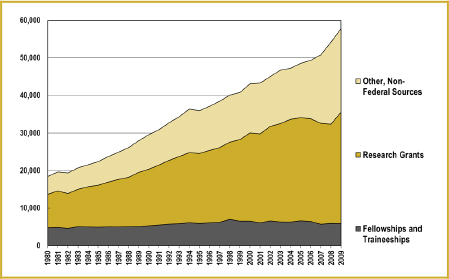
FIGURE 2-1 Variations in types of postdoctoral researchers working at academic institutions with graduate programs by mechanism of support.
NOTE: Includes science, engineering, and health postdoctoral researchers.
SOURCE: Data compiled from the NSF and NIH Graduate Students and Postdoctorates in Science and Engineering Survey (GSS) via WebCaspar.
(AAMC), and National Postdoctoral Association (NPA) all developed definitions (see Box 2-3). All converge on three basic aspects: (1) prior completion of a doctoral degree; (2) a primary focus on advanced research training (that includes publications, grants, and professional networking); and (3) a fixed term of appointment.4
Although the experience of some postdoctoral researchers does come close to the ideal principles and definitions, increasingly the current reality differs—sometimes in extreme ways. One factor driving this divergence is the sharp increase in the number of postdoctoral researchers. Fewer recent U.S.-trained doctorates have definite commitments now than at the time of the publication of
Box 2-3
Postdoctoral Researcher: Definitions and Characterizations
• National Institutes of Health and National Science Foundation (2007): “An individual who has received a doctoral degree (or equivalent) and is engaged in a temporary and defined period of mentored advanced training to enhance the professional skills and research independence needed to pursue his or her chosen career path.”
• National Postdoctoral Association (2007): “A postdoctoral scholar (‘postdoc’) is an individual holding a doctoral degree who is engaged in a temporary period of mentored research and/or scholarly training for the purpose of acquiring the professional skills needed to pursue a career path of his or her choosing.”
• Association of American Medical Colleges (2006): “Postdoctoral training is an integral component of the preparation of scientists for career advancement as scientific professionals. Postdoctoral appointees typically join an institution to further their training in a chosen discipline after recently obtaining their terminal degree (e.g., Ph.D., MD, DVM). This training is conducted in an apprenticeship mode where she/he works under the supervision of an investigator who is qualified to fulfill the responsibilities of a mentor. The postdoctoral appointee may undertake scholarship, research, service, and teaching activities that together provide a training experience essential for career advancement.”
SOURCES:
NSF: The National Science Foundation. “Proposal and Award Policies and Procedures Guide: Part I - Proposal Preparation & Submission Guidelines (GPG).” Effective June 1, 2007. NSF 07-140. OMB Control Number: 3145-0058. April 2007.
NIH: Available at http://grants1.nih.gov/training/q&a.htm. Accessed May 8, 2014
NPA: Available at http://www.nationalpostdoc.org/social-media-terms. Accessed May 8, 2014
AAMC: Association of American Medical Colleges. “Compact between Postdoctoral Appointees and Their Mentors.” Washington, DC, 2006.
_____________________________
4 The period of postdoctoral appointments is highly variable, with terms ranging from a year to a decade. It should be noted that, whereas the definitions used by the NIH, NSF, and NPA all state explicitly that a postdoctoral position is a “temporary” position, the AAMC definition only does so implicitly by referring to it as “training conducted in an apprenticeship mode,” (see Box 2-3).
the 2000 Postdoctoral Report, regardless of field,5 and those that do are more likely to declare that they are entering into a postdoctoral research position. Nearly 40 percent of all 2012 doctorate recipients with postgraduate plans were committed to postdoctoral study, according to the most recent NSF SED data, down slightly from its all-time high of more than 43 percent in 20106 when American Recovery and Reinvestment Act funding for postdoctoral scholars was available. Limiting the data to just life science, physical science, social science, and engineering, the rate increases to approximately 50 percent in 2012.7 In the United States alone, an estimated 60,000 to 100,000 postdoctoral researchers work in various research fields. According to the GSS, postdoctoral researchers in the biomedical sciences constitute the largest fraction of the current U.S. postdoctoral population, followed by those in the physical sciences (see Figure 2-2). Globally, it is estimated that the number of postdoctoral researchers may be anywhere between 250,000 and 400,000 (Gallagher 2012).
There is a wide variation in the experience of postdoctoral researchers—a variation that is due to the diversity of practices in the scientific enterprise. In fact, there appears to be no standard practice in the ways in which postdoctoral researchers are hired, mentored, and transitioned.
Location
Most postdoctoral researchers are based in universities and other research centers. Universities obviously cannot provide jobs for all of their postdoctoral researchers at the end of their terms, and the committee members agreed that in their experience, at a wide variety of universities, the expectation is that the postdoctoral researchers will find jobs elsewhere. In contrast, private companies and national laboratories often view the postdoctoral period as an opportunity to observe potential employees, and many hire their own postdoctoral researchers into more permanent positions at the end of their research contracts.
Most discussions of postdoctoral training refer to postdoctoral researchers working at universities, but approximately 11 percent work at federally funded research and development centers (FFRDCs) such as national laboratories, or in industry research and development centers.8 Testimony from current postdoctoral researchers and the experience of some committee members
_____________________________
5 Aggregate across all disciplines, between 2000 and 2012, the percentage of recent U.S.-trained doctorates with definite commitments has fallen from above 70 percent to around 65 percent. For recent U.S.-trained doctorates in only life science, physical science, social science and engineering, the decrease has been from nearly 60 percent to approximately 51 percent.
6 For a detailed discussion regarding sources of data on the postdoctoral population, please see Chapter 1.
7 In the SED data life sciences include agricultural sciences, natural resources, biological and biomedical sciences, and health sciences; physical sciences include mathematics and computer and information sciences; social sciences include psychology.
8 The 11 percent figure is derived from a combination of NSF survey data (SED, SDR, GSS, and the FFRDC postdoc surveys).
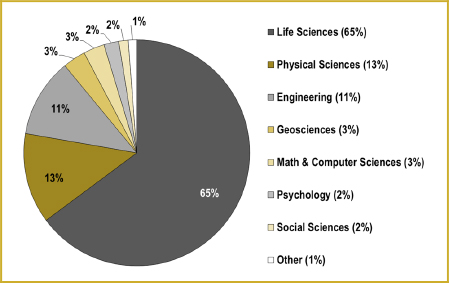
FIGURE 2-2 Doctoral degree (Ph.D., Sc.D., D.Eng. only) holding postdoctoral researchers in academia as reported by host institutions, by field: 2012.
NOTES: In fall 2012, GSS data were collected from 13,952 departments or organizational units at 367 SEH doctorate-granting institutions and 198 SEH master’s-granting institutions, for data on 43,426 doctoral degree (Ph.D., Sc.D., D.Eng. only) holding postdoctoral researchers. “Other” includes Architecture and Environmental Design, Communication and Librarianship, Interdisciplinary or Other Sciences, and Vocational Studies and Home Economics.
SOURCE: Data compiled from the NSF and NIH Graduate Students and Postdoctorates in Science and Engineering Survey (GSS) via WebCaspar.
indicated that the experience of these postdoctoral researchers differs in significant ways from their academic counterparts: salaries are higher, the term of the appointment is usually shorter, their position in the institution is more clearly defined, and there is a reasonable chance that the postdoctoral researcher will eventually be hired for permanent employment. For the FFRDCs, postdoctoral fellows are increasing in importance for attraction of top scientific talent. For this reason, and motivated by feedback from postdoctoral researchers, the FFRDCs are currently collaborating to increase the quality of research experience and mentoring received by postdoctoral researchers.
Type
Funding for postdoctoral research positions at universities commonly falls into three main categories: fellowships, training grants, and research grants. Currently, the vast majority fall into the latter category. Figure 2-1 (above) shows that the number of postdoctoral researchers on fellowships and traineeships has remained fairly constant over the past several decades. However, there has been notable growth in the number of postdoctoral
researchers supported by research grants and those supported by nongovernmental sources, including foundations and other governments.
Postdoctoral researchers with some independent competitive fellowships often have at least some direct control over their research topic and can typically choose where to study and to relocate, if desired. Such portability is an advantage. Typically, training grants are awarded to research institutions, and postdoctoral researchers are selected by the grant-receiving institution, but when the postdoctoral researcher holds the traineeship, she or he may retain some flexibility in choice of research topic. The most common type of funding mechanism is through the principal investigators, who recruit postdoctoral researchers directly to work on research grant awards they have been able to secure from federal or private sources. In this model, postdoctoral researchers work under the direct supervision of principal investigators in an area that is of interest to their host laboratories, and they have little mobility.
Field
Postdoctoral experiences also vary significantly by research fields. Many of these differences are due to specific disciplinary factors, such as the time it takes to produce data from research experiments and publish in peer-reviewed journals, the availability of funding for various research areas, and the availability of jobs that require postdoctoral research experience.
Over the past two decades, the percentage of Ph.D. recipients who entered postdoctoral positions grew in every discipline (see Figure 2-3), with the rate of growth fastest in those disciplines where postdoctoral training was relatively rare in 2000, such as engineering (up 13.3 percentage points between 2000 and 2012) and the social sciences (up 12.7 percentage points between 2000 and 2012). The most recent Survey of Earned Doctorates (SED) data for Ph.D. recipients who earned degrees at U.S. institutions in 2012 indicate that more than 65 percent of life scientists, almost 55 percent of physical scientists, nearly 35 percent of engineers, and more than 36 percent of social scientists with definite commitments were entering postdoctoral training.9 Ph.D.’s in the biomedical sciences have traditionally been the most likely to pursue postdoctoral training, with rates above 60 percent for more than a decade. Excluding the humanities, the social sciences and engineering have the lowest percentage of U.S.-degreed Ph.D.’s entering postdoctoral training. The physical sciences fall in the middle for rates of postdoctoral participation. In terms of duration, a single postdoctoral appointment still lasts approximately 2 years (2006 Survey of Doctorate Recipients [SDR] data), but in total, an individual
_____________________________
9 In 2012, the percentage of recent U.S.-trained doctorates with definite commitments in the life sciences was just over 62 percent, physical sciences was just over 68 percent, engineering was approximately 64 percent, and social sciences was nearly 70 percent.
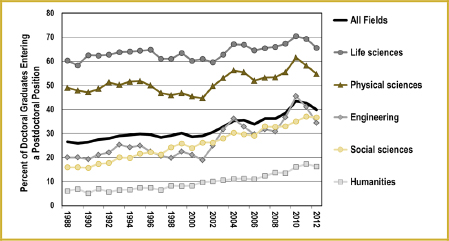
FIGURE 2-3 Percent of U.S.-trained doctorates with definite commitments in a given year that go on to postdoctoral positions that year by broad fields of research.
SOURCE: Data compiled from the NSF, NIH, U.S. Department of Education, U.S. Department of Agriculture, National Endowment for the Humanities, and NASA Survey of Earned Doctorates (SED): 2012, 2011, 2010, 2009, and 2008.
spends a median of 3 to 4 years as a postdoctoral researcher.10 It is not unusual to find biomedical researchers who have completed several postdoctoral appointments that total more than 5 years.
The employment of postdoctoral researchers varies by field as well. According to the SDR, which follows only U.S.-degreed Ph.D. recipients, the life and physical sciences have the highest percentage of postdoctoral researchers in the academic workforce—both more than 10 percent of the total workforce—and the correspondingly lowest percentage of tenure and tenure-track faculty (see Figure 2-4). It is important to note that this most likely is a dramatic undercounting of the use of postdoctoral researchers, caused by the limited sampling frame of the survey.
Postdoctoral salaries cover a wide range;Table 2-1 compares median annual salaries for individuals who recently received their science, engineering,
_____________________________
10 Kahn 2011 and from the supplemental material of the NIH Biomedical Workforce Report: “Median length of time with the title postdoc, estimated from the SDR. Because the SDR only covers US-trained doctorates and because foreign doctorates may do longer postdocs, this number may be an underestimate. For comparison purposes, with 8700 postdoctoral entrants per year and 68,000 total postdocs, we would expect a mean postdoc length of 7.8 years (due to the distribution being right-skewed, we do expect the mean to be larger than the median).” Available at http://report.nih.gov/investigators_and_trainees/ACD_BWF/PhD_Postdoctoral.aspx. Accessed July 7, 2014.
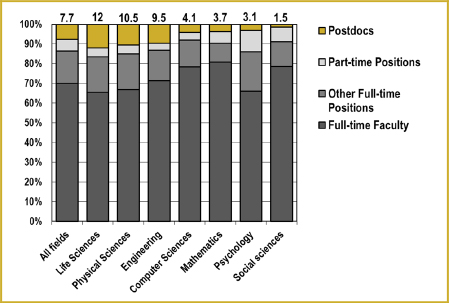
FIGURE 2-4 U.S.-trained science, engineering, and health doctorate holders employed in academia, by type of position and degree field, 2010.
NOTES: “Academic employment” is limited to U.S. doctorate holders employed at 2- or 4-year colleges or universities, medical schools, and university-based research institutes. “Physical sciences” include earth, atmospheric, and ocean sciences; “life sciences” include biological, agricultural, environmental, and health sciences. “Full-time faculty” includes full-time professors, full-time associate professors, and full-time junior faculty. “Other full-time positions” include research associates, adjunct positions, lecturers, instructors, and administrative positions. “Part-time positions” exclude those employed part time because they are students or retired.
SOURCE: Science and Engineering Indicators 2014; NSF, NCSES, special tabulations (2013) of the SDR (various years).
or health doctorates in the United States and had definite postgraduation commitments in employment or postdoctoral study. Postdoctoral researchers in some disciplines, at some institutions, and in some highly competitive fellowship positions earn salaries above $80,000 per year,11 but median salaries are considerably lower. Beginning postdoctoral researchers in mathematics and computer science, business management, and economics reported median salaries above $56,000 a year in 2012, but the median for all postdoctoral researchers within five year of receiving their degree was only around $43,000
_____________________________
11 NSF, NIH, U.S. Department of Education, U.S. Department of Agriculture (USDA), National Endowment for the Humanities, NASA, SED, 2012.
TABLE 2-1 Median salaries for recent U.S. science, engineering, and health (SHE) doctorate recipients in postdoc and non-postdoc positions up to 5 years after receiving degree: 2010 (Dollars)
| Field of doctorate | Non-postdoctoral position | Postdoctoral position |
| All SEH | 76,000 | 43,000 |
| Life sciencesa | 65,000 | 42,000 |
| Physical sciences | 76,000 | 44,000 |
| Computer & information sciences | 97,000 | 48,000 |
| Mathematics & statistics | 70,000 | 53,000 |
| Psychology | 64,000 | 43,000 |
| Social sciences | 64,000 | 44,000 |
| Engineering | 91,000 | 44,000 |
| Health | 77,000 | 47,000 |
a Includes Biological, agricultural, and environmental life sciences.
NOTE: Salaries are rounded to the nearest $1,000. Data include graduates from 15 months to 60 months prior to the survey reference date.
SOURCE: National Science Foundation, National Center for Science and Engineering Statistics, Survey of Doctorate Recipients (2010), http://sestat.nsf.gov. Science and Engineering Indicators 2014
in 2010. These salaries are considerably lower than what their peers who pursued regular employment were earning.
Funding Source
The bulk of the federal funding for science, engineering, and health postdoctoral researchers in the United States comes from the NIH (~ 60 percent of federally supported postdoctoral researchers at academic institutions) and NSF (~12 percent of federally supported postdoctoral researchers at academic institutions). NIH funding is focused on biomedical and biomedical-related sciences; NSF funds research across a broad spectrum of physical sciences, engineering, social sciences, and some non-medical life sciences. Other federal agencies providing postdoctoral funding include the Department of Defense, the Department of Energy, NASA, and USDA.
Nonfederal funding also plays a role in postdoctoral researcher support, with more than 36 percent of postdoctoral researchers for whom sources were known either self-supporting or receiving nonfederal funding. Ranked by percentage of the total number of science, engineering, and health postdoctoral researchers at academic institutions supported (both federal and nonfederal), the reported sources are as follows: nonfederal–institutional (18–19 percent), nonfederal–domestic (13–14 percent), unknown/not reported (~7 percent), nonfederal–foreign (~3 percent), and self-support (<1 percent) (see Figure 2-5).
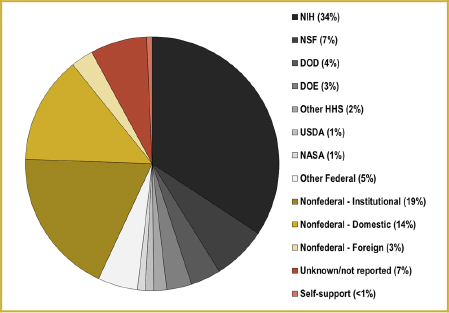
FIGURE 2-5 Postdoctoral appointees in science, engineering, and health in academic institutions, by field and primary source of support: 2012.
NOTES: Details on primary mechanism and source of support for postdoctoral researchers were collected for the first time in 2010. Percentages may not total to 100 percent due to rounding.
SOURCE: Data compiled from the NSF and NIH Graduate Students and Postdoctorates in Science and Engineering Survey (GSS) via WebCaspar.
The demographics of the postdoctoral population have changed in recent years. The percentage of women, temporary residents, and underrepresented minorities among postdoctoral researchers has continued to increase.
The beginning of this report includes a discussion of the committee’s approach to the available data that is particularly relevant to this discussion of demographics.12 The SED data includes detail on ethnicity, but does not include postdoctoral researchers who earned their degrees outside the United States. The GSS data include postdoctoral researchers with foreign Ph.D.’s, but does not collect data from some types of institutions that hire postdoctoral researchers. Additionally, international postdoctoral researchers may have funding from their home country and are, therefore, not included in the calculations of NIH, NSF,
_____________________________
12 Further discussion in Chapter 1.
and other U.S. funders.13 As a result, the committee finds only enough reliable evidence to identify a few significant trends in the postdoctoral population that are consistent across several datasets. They are summarized below, in percentages that are not meant to be precise.
International Postdoctoral Researchers
The available data indicate that more than half and as many as two-thirds of all postdoctoral researchers working in the United States are on temporary visas, and this percentage has been increasing consistently for decades.14 According to GSS data, the percentage of temporary residents in the postdoctoral population has increased about 10 percentage points in the past 25 years. It has consistently been more than 50 percent in the physical sciences and 60 percent in engineering, and a surge of temporary residents in the life sciences—from about 30 percent to 50 percent—has accounted for almost all of the growth.
Independent research has found that among people earning a Ph.D. in the United States, noncitizens are more likely to pursue postdoctoral training (see Figure 2-6), and that noncitizen postdoctoral researchers produce more publications on average than do their citizen counterparts (Corley and Sabharwal 2007; Cantwell and Lee 2010; Stephan and Ma 2005). It is evident that the U.S.
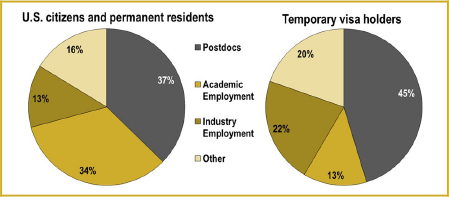
FIGURE 2-6 Commitments by citizenship, 2012. Ph.D. recipients from the United States only.
NOTE: “Other” includes government, nonprofit, other/unknown, and unreported sector but reported commitment to employment.
SOURCE: Data compiled from the NSF, NIH, U.S. Department of Education, U.S. Department of Agriculture, National Endowment for the Humanities, and NASA Survey of Earned Doctorates (SED): 2012.
_____________________________
13 Although some institutions and disciplinary or professional societies have collected data on international postdocs in selected fields, there are no consistent and comprehensive data. This situation may be ameliorated with recent requirements for NIH grants to enumerate all laboratory personnel regardless of funding source.
14 These include foreign nationals who received their Ph.D.’s in the United States as well as foreign-trained Ph.D.’s who first come to the United States for their postdoctoral position.
research enterprise is heavily dependent on noncitizen researchers, and therefore it would be prudent to know more about how many of such researchers there are, what their goals and expectations are, how satisfied they are with their training, and what should be done to make their experience more satisfying. The current system is dependent on a ready supply of highly skilled researchers who are willing to spend several years away from their home country, with only a moderate prospect for a permanent, full-time research position in this country at the end.15
Other Demographic Trends
The percentage of women in the postdoctoral population has grown between 10 and 20 percentage points in the past 25 years, depending on the field, with the life sciences increasing from below 25 percent to nearly 45 percent and the physical sciences and engineering increasing from below 10 percent to around 20 percent (GSS data). The percentage of women is higher among those who earned their Ph.D.’s in the United States than among those with foreign degrees. The rate of increase has been roughly the same in both populations.
The SED survey of those with U.S. Ph.D.’s indicates that the percentage of those with definite commitments for postdoctoral positions who are white is declining slightly, but whites still account for about 80 percent of the total. The GSS survey has not asked for ethnic information until the most recent survey years, so nothing definitive can be said about trends in those data. However, it is clear that some ethnic groups, particularly African Americans and Hispanics, are not proportionately represented in the postdoctoral population, either when compared to the U.S. population or with their representation in the population of doctoral degree recipients. The U.S. Census estimates underrepresented minorities (URM), including American Indian or Alaska Native, Black, Non-Hispanic, Hispanic, and Native Hawaiian and Other Pacific Islander, made up over 30 percent of the total population in 2012.16 According to the GSS, URM U.S.-degreed postdoctoral researchers made up only approximately 9.5 percent of the total postdoctoral researcher population in 2012.17 NIH director Francis Collins, among others, has acknowledged the problem and pledged to do more to increase diversity in the research community (Tabak and Collins 2011). None of the surveys ask about the ethnicity or country of origin of postdoctoral researchers who are temporary residents, even though they may make up over half of the total postdoctoral population. Studies of graduate students reveal that the largest sources of such students on temporary visas are China and India
_____________________________
15 Additional information about the unique challenges of international postdoctoral researchers in the United States can be found in Appendix A.
16 More information can be found at http://factfinder2.census.gov/faces/nav/jsf/pages/index.xhtml last accessed September 9, 2014.
17 See also Einaudi 2013.
(CRS 2012), and it is likely that the composition of the postdoctoral population is roughly similar.
Although postdoctoral researchers are developing new skills, a postdoctoral research position is also a “job.” Practical matters, such as salary and benefits, career guidance, and personal concerns, are significant. The inherent short-term nature of postdoctoral employment can add complications. Moreover, immigration rules, sub-optimal communication skills, and cultural differences may pose a special challenge for postdoctoral researchers who are non-U.S. citizens.
Changes in the science and engineering enterprise—fueled by global collaborations, recent economic turmoil, and tight labor markets—have led to additional imbalances in the system. The postdoctoral population is growing more rapidly than the number of tenure track faculty positions at research universities. Among the results of this imbalance are that many individuals are staying as postdoctoral researchers for prolonged periods, and sometimes moving into a second or a third postdoctoral position; some attain research positions for which postdoctoral training was not necessary; and others are leaving their chosen research field or abandoning their research pursuits altogether.
In summary, research training beyond the Ph.D. continues to be a vital period for many researchers. However, the ideal experience defined a for postdoctoral researcher—“a temporary and defined period of mentored advanced training to enhance the professional skills and research independence needed to pursue his or her chosen career path”—is often not mirrored in reality. The characteristics of current postdoctoral experiences depend greatly on the source of funding, the research discipline, the approach of the principal investigator, and institutional setting.
This page intentionally left blank.
















